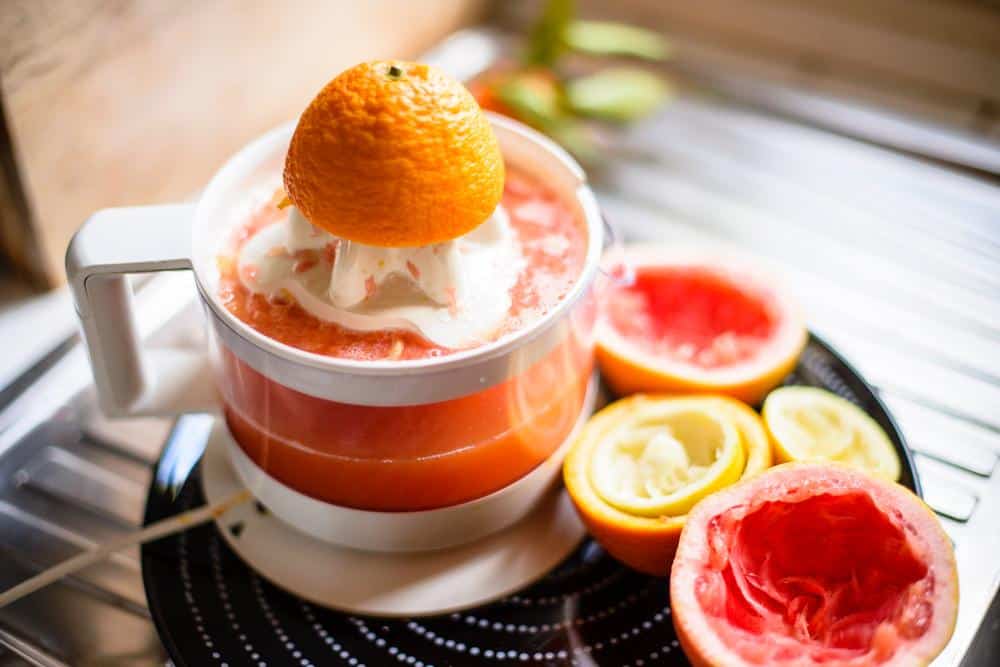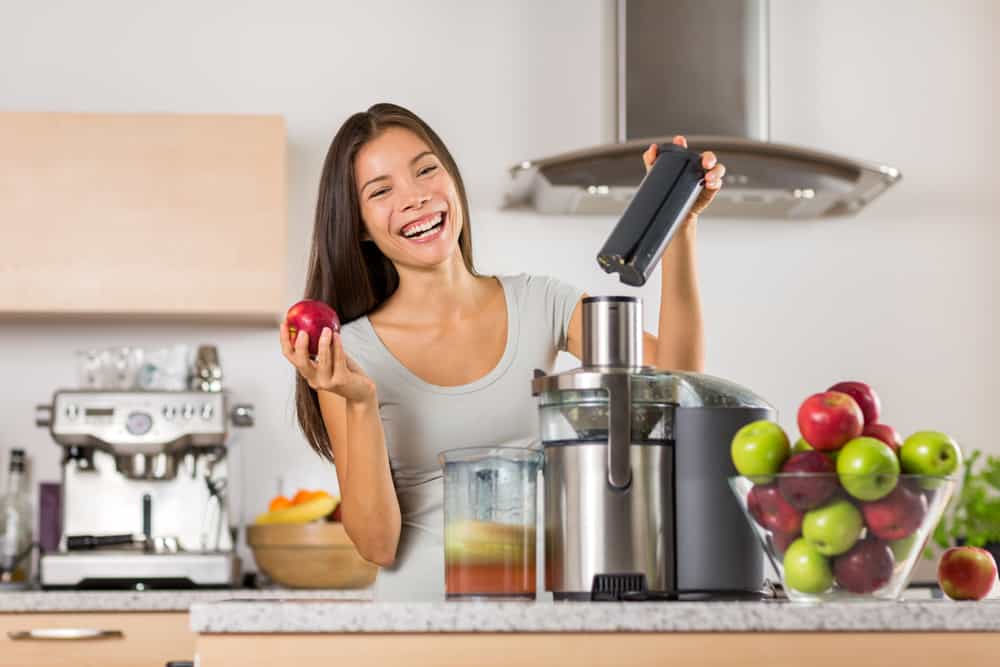In this post, we cover all the different types of manual and electric juicers and the features that you might want to consider when looking to purchase a juicer.
An electric citrus juicer is a citrus juice press that is specifically designed for juicing citrus fruits like oranges and grapefruit. They are a small countertop appliance that provides you with fresh juice in as little as 10 seconds.

Citrus Juicer
This type of juicer typically has one or more conical-shaped strainers called juicing cones that are lined with ridges. You'll cut your citrus fruit and half and place it over the top of the juicing cone. For most citrus juicers, you'll then fully enclose the fruit by closing the lid assembly and start the juicing process by pressing a button on the device.
Fruit juice is then extracted from the fruit and ends up in the onboard plastic juicing bowl that comes with most citrus juicers. Many juicers come with pulp filters to ensure that you get just the right amount of pulp in your juice.
The overwhelming majority of citrus juicers can be purchased for under $100. For commercial, high volume use, juicers can get pretty pricey. Commercial juicers like the Waring Commercial Heavy-Duty Hi-Power Citrus Juicer come with a relatively hefty price tag: list price of $723.
Citrus Juicers come in a variety of finishes and colors. Stainless steel is a very common finish for juicers. Easy to clean and a match for most of the appliances in many kitchens, it is a popular choice.
You can also get a citrus juicer in silver, black, grey, red, and blue.
Centrifugal juicers are one of the most popular types of juicers on the market. They are relatively inexpensive and easy to use, and they extract juice quickly and efficiently.
They're also very easy to clean when compared to other juices due to their more simple design that requires fewer parts. Fewer parts mean an easier cleaning experience.
A Hamilton Beach Centrifugal Juicer
However, centrifugal juicers have some downsides. The juicers revolve at extremely high speeds. This can make the machines extremely noisy.
Oxidation and heat are also byproducts of these high-speed centrifugal juicers. You may notice foam on top of your juice, this is due to oxidation. Excess oxidation can result in nutrient loss and reduced shelf life for your juice. 
Who knew juice machines could be so much fun?
Centrifugal juicers only do a mediocre job when it comes to leafy green vegetables like kale and spinach. They also struggle with wheatgrass - if you're looking for a wheatgrass juicer that can also do leafy veggies, be sure to check out masticating juicers.
Additionally, centrifugal juicers can be difficult to clean, as the blades can be tough to remove. Despite these drawbacks, centrifugal juicers remain a popular choice for many people, thanks to their convenience and affordability.
A masticating juicer is a type of juicer that uses a slow crushing and grinding motion to extract juice from fruits and vegetables. These juicers operate at a much lower speed than centrifugal juicers. This process results in less oxidation, meaning that the juice will stay fresh for longer.
The masticating juicers also produce a higher volume of juice than a centrifugal juicer. They also provide a tastier end product when compared to a centrifugal juicer.
The Omega MM1500 Omega Slow Juicer
These cold press juicers also tend to preserve more nutrients than other types of juicers, making them a healthier option. They do an excellent job with leafy greens and wheatgrass - unlike centrifugal juicers.
On the downside, masticating juicers are usually more expensive than other types of juicers. Typical retail pricing for masticating juicers is between $100 and $200. This is anywhere from 50% to 100% more than a centrifugal juicer.
These juicers also require quite a bit of effort to clean when you're done using them when compared to centrifugal juicers.
A triturating juicer, also known as a twin-gear juicer, is a type of juicer that uses two interlocking gears to crush and grind fruits and vegetables. The twin gears are highly effective at working with just about any fruit, vegetables, or nuts that you throw at them. This includes soft fruits - which can be a challenge for other juicers (especially centrifugal juicers). The triturating juicer is the most versatile juicer option you can purchase.
Triturating juicers extract more juice and nutrients than other juicer types, making it ideal for those who are looking for the highest quality juice possible. They also operate quite quietly - they just don't make a lot of noise in your kitchen.
However, these twin gear juicers are also much more expensive than other juicer options. They're also harder to clean and run quite a bit larger than other juicers - meaning that they'll take up more of your counter space. Additionally, their slow operation can make them less suitable for busy households - or when you need your juice in a hurry.
A manual juicer is a device that you can use to extract juice from fruit. You simply place the fruit in the juicer and then use a lever to manually press it and extract the juice into a container below the device.
A manual juicer is much different than an electric juicer because they don't rely on electricity to operate - you do all the work yourself. Manual juicers are also very quiet, so you won't have to worry about disturbing anyone if you're using it early in the morning or late at night.
Manual juicers typically have filters that remove pulp from the final product, leaving you with pure, fresh juice.
The tradeoff for all these benefits is that manual juicers are much more manually intensive than electric juicers. The repetitive motion of using the lever to extract juice could cause arm pain strain and fatigue.
These manual juicers aren't inexpensive. Many of these types of juicers are commercial grade and made of high-quality durable materials. The base in particular is solid and often comes with suction cups to keep the device in place on your counter while juicing.
Steam juicers are a type of kitchen appliance that is primarily used to extract juice from fruits and vegetables. Unlike traditional juicers, which rely on centrifugal force or grinding and crushing to extract juice, steam juicers use steam to break down the cell walls of fruits and vegetables, releasing their juices.
Steam juicers are typically much more expensive than traditional juicers, but they have several advantages. They can be used to extract juice from blackberries, strawberries, and other delicate fruits that would be damaged by a traditional juicer. Additionally, juice extracted by a steam juicer has a longer shelf life. Some steam juicers can even be used to make non-dairy milk like almond milk and soy milk.
On the downside, the steaming process can destroy many of the nutrients from the fruit or vegetable.
During your search for a juicer, you'll notice that there are vertical and horizontal juicer options.
Vertical juicers are a type of juicer that uses gravity to assist in the juicing process. By placing the produce on top of the juicer, gravity helps to push it down into the blades, making it more effective at extracting juice. A vertical masticating juicer also tend to be faster and more efficient in generating your fruit or vegetable juice.
Horizontal juicers are a type of juicer that many people prefer because they are easier to clean and have fewer moving parts than vertical juicers. They are also generally less expensive than vertical juicers.
When in operation, these juicers are relatively quiet when compared to their vertical counterparts - which many may see as an advantage. The horizontal masticating juicer is also great at extracting juice from leafy veggies like kale and spinach.
A couple of drawbacks to horizontal juicers are speed and counterspace. Horizontal juicers extract juice much more slowly than vertical juicers. The fact that these juicers have a horizontal alignment means that they're going to take up more counter space in your kitchen than other types of juicers.
Some juicers come with a variety of automatic presets so that you can get the juice the exact way that you want it. Here are some of the juicing settings that come pre-programmed with many juicers:
Pulse control is an option on blenders and some juicers that allows you to turn on the device for very quick bursts. The pulse control helps to prevent you from overprocessing your fruits and vegetables.
Juicers with parts that are dishwasher safe save you time and energy when cleaning up after juicing. Look for a model that has as many dishwasher-safe parts as possible, including the pulp container, juice pitcher, and cutting blade.
A juicer's pulp bin is where the separated pulp from fruits and vegetables collects after they have been juiced. Most juicers have an external pulp container that automatically collects the pulp. You'll need discard the pulp bin periodically as the pulp accumulates.
A juicer's dispenser spout can be used to pour juice directly into a glass or other container. These can be extremely convenient if you're thirsty as you won't have to transfer the juice from a container directly to your glass.
Many juicers come equipped with a locking lid. The locking lid is a safety feature to prevent getting fingers or clothing caught up in the juicer. Most juicers with this safety feature won't operate unless the lid is locked.
Juicers come with a feed chute that is used to load the fruits or vegetables into the juicer. The size of the feed chute is an important consideration. A smaller feed chute will require additional prep time to chop up fruits and vegetables to a small enough size to fit into the feed chute.
To help guide your fruit and vegetables through the feed tube, many juicers come equipped with a push rod (or pusher). You'll insert the pusher into the feed tube and periodically push it down to enable the juicing process.
An extremely handy feature for many juicers is a travel cup. You can put your travel cup underneath the dispenser spout. Once juicing has completed, put the accompanying lid on your travel cup and enjoy your juice on the go.
